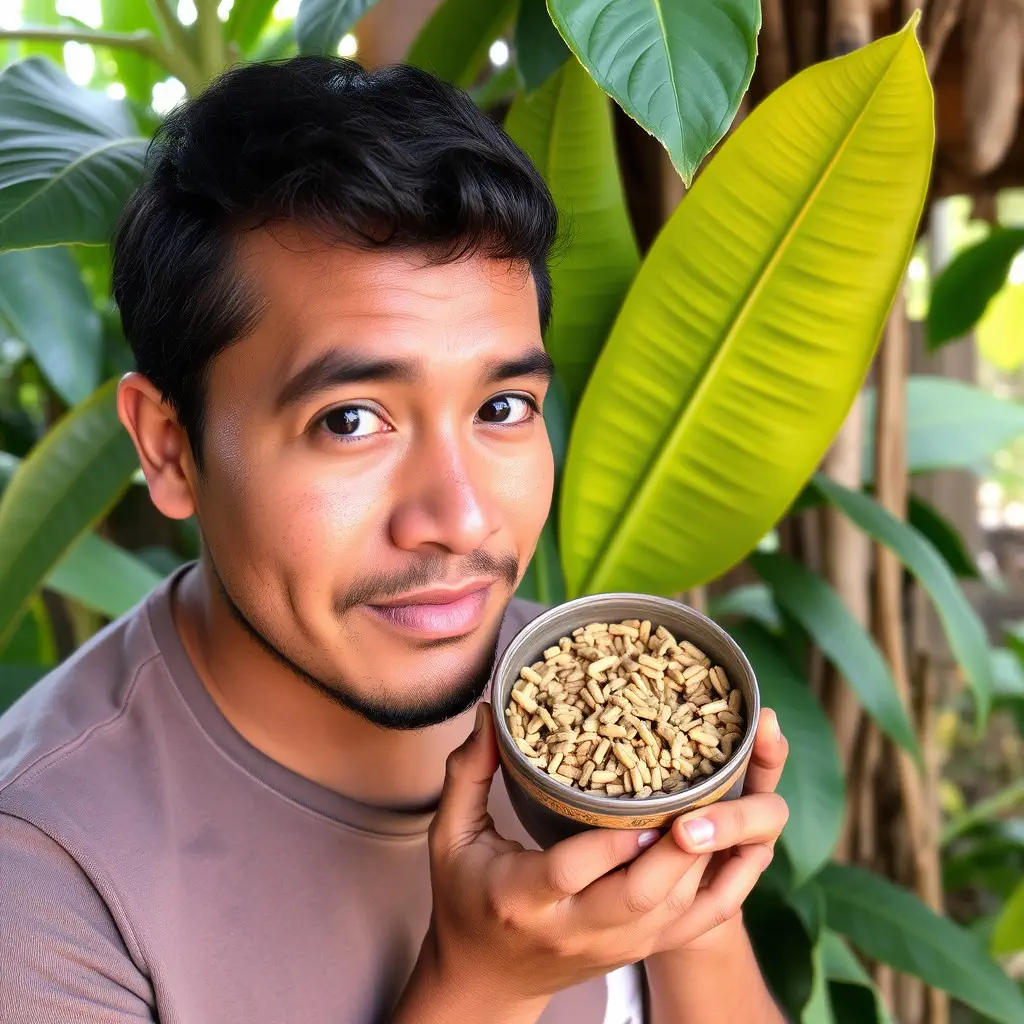Vietnamese Kratom, derived from the Mitragyna speciosa tree, is noted for its high alkaloid content, including mitragynine and 7-hydroxymitragynine, which set it apart in the natural supplement market. The unique environmental conditions of Vietnam's tropical climate and fertile soil contribute to its distinctive alkaloid profile, potentially influencing efficacy and a wide range of effects from mood elevation and energy boost at lower doses to relaxation and pain relief at higher amounts. The interplay between these alkaloids and the body's opioid receptors allows for both stimulant and sedative effects based on consumption. Vietnamese Kratom is also distinct when compared to other regional strains, with some users attributing its effects to the specific soil and climate of Vietnam and cultivation practices. The combination of Vietnamese Kratom with barberry root tea, which contains alkaloids like berberine and oxyberberine, is suggested for potential complementary benefits to well-being. Users are cautioned to adhere to safe dosing guidelines and seek medical advice when integrating these natural remedies into their health regimen, considering their individual health needs and the potential for side effects and interactions with other treatments. Barberry root tea, in particular, is celebrated for its anti-inflammatory and antimicrobial properties and its role in supporting digestive health, offering a complementary alternative to Kratom's mood and energy-enhancing effects. This synergy between traditional Vietnamese herbal practices and modern scientific understanding highlights the potential of these remedies when used responsibly for promoting well-being.
Discover the unique properties of Vietnam’s Kratom leaves, a natural wonder with a rich tapestry of traditional uses within Vietnamese culture. This article delves into the potent composition and effects of Vietnamese Kratom, setting the stage for a comparative analysis with the revered barberry root tea. Explore the health implications and nuanced differences between these two botanical treasures, enhancing your understanding of their distinct roles in wellness practices. Join us as we navigate the intricacies of Vietnamese Kratom and its parallels to barberry root tea, offering insights into each plant’s contributions to holistic health.
- Unveiling the Potency of Vietnamese Kratom Leaves: An Overview of Their Composition and Effects
- The Cultural Significance of Kratom in Vietnam and Its Traditional Uses
- Comparing Vietnamese Kratom to Barberry Root Tea: Similarities, Differences, and Health Implications
Unveiling the Potency of Vietnamese Kratom Leaves: An Overview of Their Composition and Effects

Vietnamese Kratom leaves, derived from the Mitragyna speciosa tree, have garnered attention for their potent alkaloid content, which sets them apart in the realm of natural supplements. These leaves are rich in mitragynine and 7-hydroxymitragynine, among other alkaloids, which contribute to the diverse effects often reported by users. The unique environmental conditions of Vietnam’s tropical climate and fertile soil contribute to a distinct composition of these Kratom leaves, potentially influencing their efficacy and the breadth of their applications. Users frequently report a range of effects from Vietnamese Kratom, including mood elevation and heightened energy levels at lower doses, and relaxation and pain relief at higher doses. The alkaloids found in these leaves interact with the body’s opioid receptors, providing both stimulant and sedative qualities depending on the dose and strain.
In addition to their alkaloid profile, Vietnamese Kratom leaves are often compared to strains from other regions due to their unique properties. The effects are said to be more pronounced in some cases, which may be attributed to the soil composition, climate, and the way the plants are cultivated. It’s also worth mentioning that some users incorporate barberry root tea into their regimen for added health benefits. Barberry root, known for its own alkaloid content, is sometimes believed to complement Kratom’s effects, potentially enhancing well-being and vitality. As with any supplement, it is crucial to approach the use of Vietnamese Kratom with care and consideration, adhering to appropriate dosage guidelines and consulting with healthcare professionals when necessary.
The Cultural Significance of Kratom in Vietnam and Its Traditional Uses

In the rich tapestry of Vietnamese tradition, kratom leaves have held a place of significance for generations. Known locally as “cai gao” or “thar” among other regional names, these leaves are steeped in cultural importance and have been used in traditional medicine practices. The Vietnamese have employed kratom not only for its stimulant properties but also as a remedy for pain relief and to enhance work performance in agricultural settings. Historically, kratom was often chewed or brewed into a tea, with some villagers even incorporating it into barberry root tea, a practice that combines the herbal attributes of both plants for an invigorating effect. This synergy is particularly valued in rural communities where physical labor is a daily routine, and the combination has become a traditional remedy passed down through families and communities.
The use of kratom in Vietnam extends beyond mere physiological benefits; it is interwoven with local folklore and has been revered for its mythical attributes. It is believed that consuming kratom leaves can imbue one with the strength of a tiger, symbolizing its association with vitality and resilience. This cultural significance underscores the importance of the plant within Vietnamese society, where it has long been recognized as a natural resource for well-being, complementing traditional practices alongside modern herbal infusions like barberry root tea.
Comparing Vietnamese Kratom to Barberry Root Tea: Similarities, Differences, and Health Implications

Vietnamese Kratom and Barberry Root Tea are both natural remedies with a rich history of use in traditional medicine, though their origins and constituents differ significantly. Both substances have been recognized for their potential health benefits, which overlap in some areas while diverging in others.
Vietnam Kratom, derived from the Mitragyna speciosa tree, is known for its alkaloids, primarily mitragynine and 7-hydroxymitragynine, which can influence mood, pain sensation, and energy levels. On the other hand, Barberry Root Tea, sourced from the berberis species, contains active compounds like berberine and oxyberberine, which have been studied for their anti-inflammatory and antimicrobial properties. While both can offer mood-enhancing effects and pain relief, the specific alkaloids in Kratom and the berberine in Barberry Root Tea target different biological pathways, leading to distinct health implications. For instance, barberry root tea is often recommended for its potential digestive benefits due to berberine’s action on gut health, which is not a primary attribute of Kratom. In contrast, Kratom is more commonly associated with energy and mood enhancement, which can vary in intensity and effect based on the strain and dosage. Both should be consumed responsibly and within recommended guidelines to ensure safety and efficacy, as both substances have potential side effects and interactions with other medications. Users considering either of these natural remedies for health purposes should consult with a healthcare professional to determine the most appropriate choice based on their individual health needs and circumstances.
Vietnamese Kratom leaves have emerged as a subject of growing interest due to their unique compositional profile and the multifaceted effects they offer. This article has shed light on the potency of these leaves, their traditional uses within Vietnamese culture, and how they compare to barberry root tea in terms of composition, health implications, and personal well-being. As we’ve seen, while both substances share some commonalities, the nuanced differences between Vietnamese Kratom and barberry root tea underscore the importance of understanding each for those who seek their potential benefits. Whether for cultural enrichment or wellness purposes, a clearer picture has been painted regarding these natural offerings from Vietnam, inviting further research and considerate exploration by those interested in their properties.






